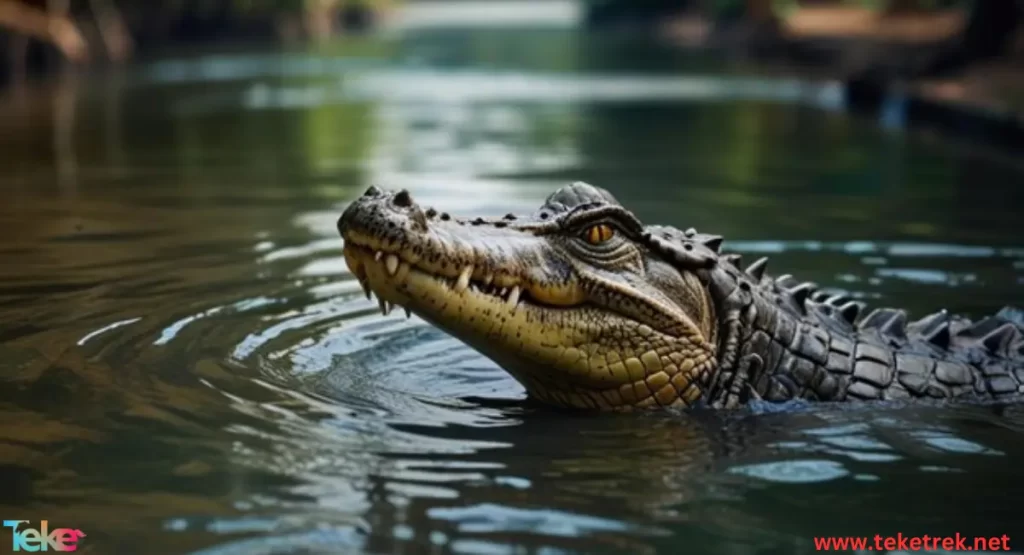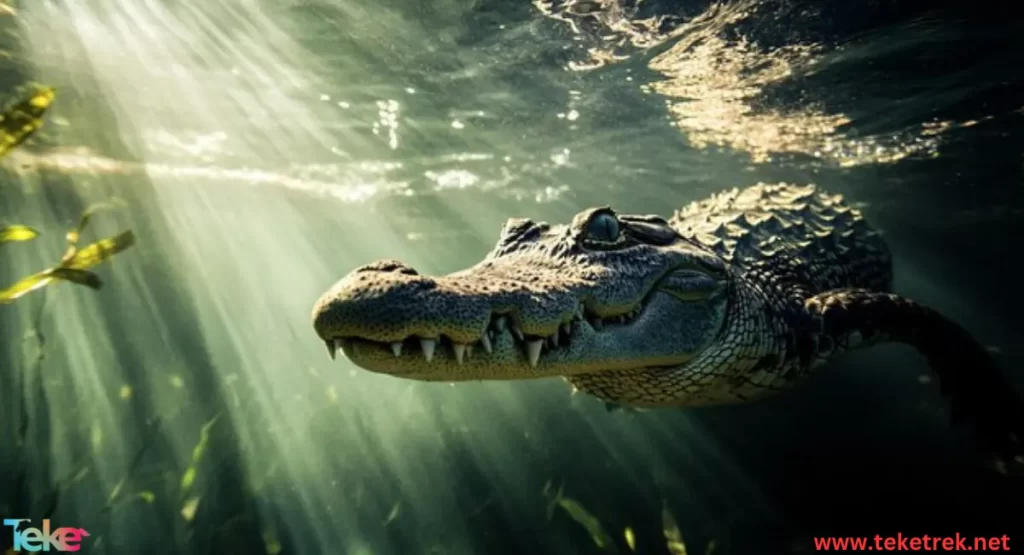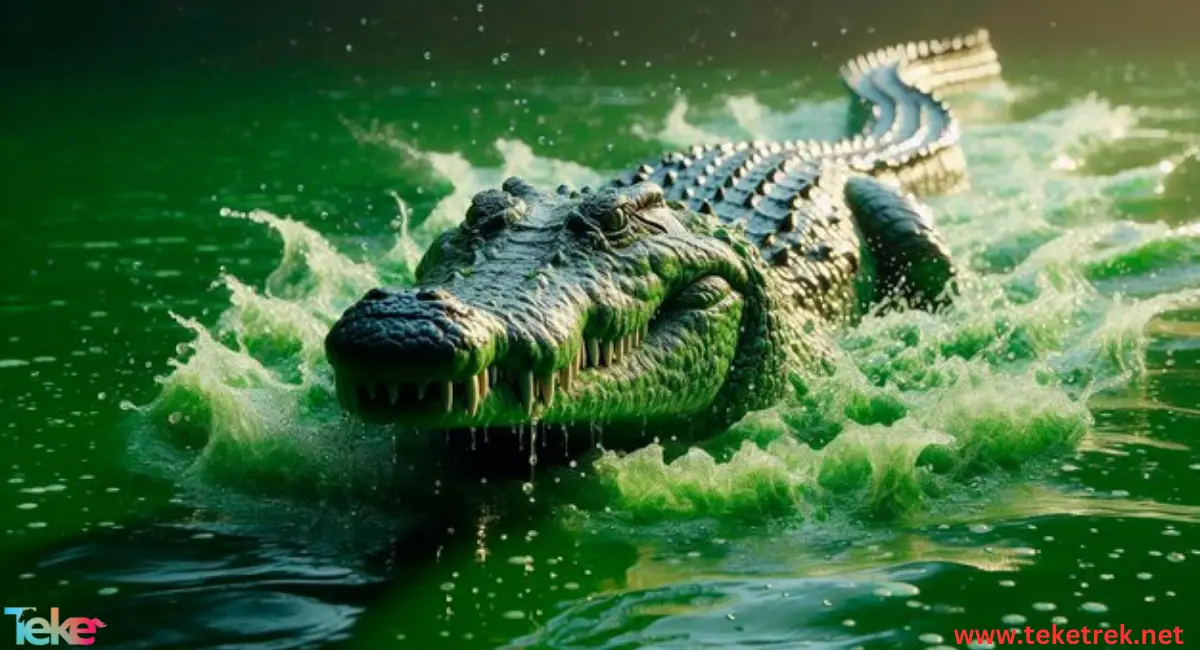Saltwater crocodiles are among the most famous and deadliest predators in the world. Just the thought of them lurking underwater is enough to evoke fear and horror.
Belonging to the class Reptilia and the family Crocodylidae, saltwater crocodiles are known for their formidable presence and powerful jaws.
Learn more about saltwater crocodiles and their lifestyle in this article from teketrek.

External Appearance of the Saltwater Crocodile:
Saltwater crocodiles are characterized by their long mouths with sharp teeth, along with eyes and nostrils located on the top of their heads.
They possess thick skin with embedded bony plates.
Saltwater crocodiles have long muscular tails, streamlined bodies, and short limbs with webbed feet equipped with claws.
Adults typically have a heavy build. The color of saltwater crocodiles ranges from golden-brown to gray to black, with irregular dark spots.
The average total length of adult saltwater crocodiles is 3-5 meters, with males usually growing much larger than females.
The habitats of saltwater crocodiles:
This species can be found in a wide range of habitats, including rivers, river mouths, ponds, as well as coastal swamps and lakes.
Saltwater crocodiles can tolerate salinity ranging from 0% (freshwater) to 35% in seawater.
It appears that riverine crocodiles are primarily limited in their movement at the source, primarily due to physical barriers such as rapids.
Saltwater crocodiles inhabit river mouths from southwestern India, eastward through Southeast Asia, the Philippines, the Indonesian archipelago, and northern Australia to the Solomon Islands.
These crocodiles are capable of traversing large expanses of open oceans, with some found in remote islands in the Indian Ocean and western Pacific, for example, in Fiji.
In Australia, riverine crocodiles are found in northern coastal areas and waterways, from Broome in northwestern Australia to the Gladstone area in southeastern Queensland.
Nutrition and Diet of Saltwater Crocodiles:
Riverine crocodiles are mostly nocturnal but also hunt during the day if the opportunity arises.
Crocodiles will eat any animal they can catch and overpower.
Young crocodiles primarily feed on small prey such as insects and crustaceans, while larger crocodiles eat larger prey including waterfowl, marine turtles, and mammals up to the size of water buffalo.
It’s also known that saltwater crocodiles are predators of humans.
Young crocodiles tend to “sit and wait” in shallow water until suitable prey comes within close range. Saltwater crocodiles may also actively chase small animals and can leap from the water to catch prey. Larger crocodiles actively hunt and are attracted to any movement that may represent a potential meal.
If the meal is too large to swallow whole, the crocodile will grip it with its jaws and shake violently or roll to tear off manageable pieces.
Since a crocodile’s tongue and skull bones are not highly mobile, food is thrust into the mouth and swallowed.
After a saltwater crocodile eats until it’s full (their stomach is relatively small), it may store the leftovers in mangrove trees or underwater to feed on later.

Behavior of the Saltwater Crocodile
The saltwater crocodile exhibits several distinctive behaviors that make it unique from other living creatures. The most prominent behaviors are as follows:
The saltwater crocodile is known for being an opportunistic predator with a robust and muscular build. It is the largest living reptile on Earth and is often referred to as the river-mouth crocodile, Indian crocodile, or Pacific crocodile.
There have been many recorded fatal attacks by saltwater crocodiles on humans, with numerous hunters dying while trying to capture these creatures.
Humans target the saltwater crocodile for its highly valuable skin, which is used to make high-end leather goods like shoes and bags. The crocodile’s hide is sold for high prices to factories.
When hunting, the saltwater crocodile lies in wait near its prey. Upon spotting an opportunity, it charges toward the prey with immense speed in a single strike, clamping it between its powerful teeth. It then begins to tear the prey apart and swallow it quickly, without chewing or tearing it into smaller pieces.
Saltwater crocodiles spend most of their time swimming, as they are semi-aquatic reptiles. Being cold-blooded, crocodiles need to spend some time on land to absorb heat and warm up their bodies during the day. Despite their massive size and powerful muscles, they become more agile and lighter in water, using their strong tail to propel themselves and swim rapidly.
The Saltwater Crocodile in Nature
The saltwater crocodile possesses certain natural characteristics that are innate to it from birth to death. This massive creature thrives in the wild by focusing on two main survival elements: food and reproduction. It does the following:
Diet: Saltwater crocodiles are carnivorous, feeding exclusively on meat. Some of their preferred prey includes fish, birds, frogs, deer, crustaceans, and rodents. These crocodiles have massive jaws, allowing them to easily capture and crush their prey before swallowing it. Unlike other animals, crocodiles cannot chew or shred food between their teeth due to their wide and deep mouths. They sometimes swallow small stones to help with digestion in their stomachs.
Crocodiles can survive for months without food due to their slow metabolism.
Reproduction: Saltwater crocodiles mate in a graceful process, where they court each other through vocalizations, body shape changes, touch, or chemical signals. After mating, the female crocodile lays between 12 to 48 eggs, which she places in one of two types of nests. These nests are either shallow pits dug in the ground, where the eggs are covered with soil to hatch, or mounds made of plants, soil, and wood to protect the eggs.
Saltwater Crocodiles in the Seas
Saltwater crocodiles inhabit various aquatic environments, and their habitat changes depending on the season and the availability of prey. The following features describe their behavior in the seas:
Saltwater crocodiles live in coastal areas, seas, oceans, and salty swamps. They are capable of surviving in saline waters due to their ability to expel salt from their bodies naturally.
They can also be found in many other parts of the world, including the eastern coast of India, Southeast Asia, and northern Australia. They are also found along the eastern coast of Africa and the opposite coast of Japan.
Saltwater Crocodiles in Rivers
Saltwater crocodiles are one of the most widespread types of crocodiles around the world, known for their massive size and lethal teeth. The following describes the saltwater crocodile’s life in rivers:
Saltwater crocodiles are found at river mouths in the Pacific and Indian Oceans. They are one of the largest and most massive reptiles, capable of growing up to 7 meters in length and weighing up to 1,000 kilograms.
They are considered apex predators and feed on prey that they hunt. Saltwater crocodiles are endangered due to habitat loss and poaching, so they often migrate to freshwater rivers in search of food to sustain their diet.
Threats Facing the Saltwater Crocodile
Saltwater crocodiles face many threats that endanger their survival in nature. The primary threats include:
- Loss of natural habitats
- Harsh winter climate changes
- Illegal hunting by humans near seas and oceans
- Pollution of seawater with garbage and oil spills
- Crocodile hunting for their skin to make expensive leather products like shoes and bags
- Young crocodiles face predation from snakes and birds of prey
These factors significantly threaten the survival of saltwater crocodiles in the wild.
The Dangers of the Saltwater Crocodile
The saltwater crocodile poses numerous life-threatening risks to humans and other living creatures. Its danger is manifested in the following:
The saltwater crocodile is considered one of the most dangerous predators, known for its enormous size and powerful muscles. This crocodile is capable of hunting prey as large as a cow or a wild buffalo. It has no natural predators threatening its life from other creatures.
The saltwater crocodile can prey on all living organisms that approach its habitat, and its preferred food includes birds, mammals, fish, crustaceans, and reptiles.
What sets the saltwater crocodile apart from other crocodile species is its superior strength and size. It can consume large amounts of meat in one sitting.
FAQs about Saltwater Crocodiles:
- What is the size of saltwater crocodiles?
Saltwater crocodiles, or riverine crocodiles, are massive creatures and are the largest living reptiles in the world. The average length of males is around 5 meters, weighing approximately 500 kilograms. Females, on the other hand, are much smaller, with an average length of just under 3 meters and weighing less than 100 kilograms.
- What is the size of the largest saltwater crocodile ever found?
The largest saltwater crocodile ever found measured approximately 6.3 meters in length. However, individuals measuring up to 7 meters in length are believed to have existed in the past. Such large crocodiles may no longer exist due to intense hunting of larger specimens. Estimates suggest that the weight of these massive crocodiles could reach 1500-2000 kilograms.
- Where do saltwater crocodiles live?
Saltwater crocodiles have a wide range, stretching from northern Australia to eastern India and Southeast Asia. As their name suggests, saltwater crocodiles are capable of living in coastal habitats, but they are also found in freshwater rivers.
These large crocodiles adapt well to life in saltwater, to the extent that they can spend days or even weeks at sea, drifting and swimming hundreds of kilometers and perhaps hunting their prey along the way.
- What determines whether a saltwater crocodile is male or female?
The temperature of the nest where the eggs are laid determines the sex of the offspring. Lower incubation temperatures generally produce females, while higher temperatures result in mostly males.
- How long do saltwater crocodiles live?
Saltwater crocodiles have a long lifespan, with many living for over 65 years. Some saltwater crocodiles may live for over a century, although this has not been verified in the wild. In captivity, there have been several reports of crocodiles living for over 100 years.
On the other hand, infant mortality rates are extremely high due to intense predation. Only about 1% of newborns survive to adulthood.
- Do crocodiles really sleep with one eye open?
The Australian myth suggests that crocodiles sleep with one eye open, and scientists have now confirmed this to be true.
Australian saltwater crocodiles join many mammals and waterfowl in the ability to sleep with one hemisphere of their brain at a time. This means they close only one eye while keeping the other half of their brain alert for danger.
- What is the ‘death roll’?
Saltwater crocodiles are known for their “death roll,” a hunting behavior designed for larger prey. After submerging its prey, the crocodile rapidly rolls it in the water to remove its extremities. Its teeth are designed to grasp meat rather than tear it apart.
In short, saltwater crocodiles must be protected to maintain ecological balance and biodiversity in the oceans. Saltwater crocodiles play a crucial role in regulating aquatic ecosystems, and it requires joint efforts to promote their conservation and preserve their natural habitats.
Sources:






I was suggested this web site by my cousin. I’m not sure whether this post is written by him as
nobody else know such detailed about my problem. You’re wonderful!
Thanks!!